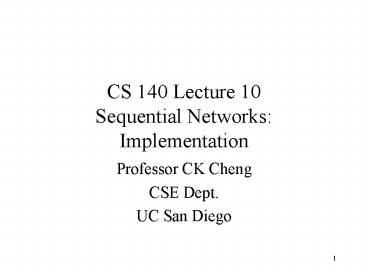CS 140 Lecture 10 Sequential Networks: Implementation - PowerPoint PPT Presentation
Title:
CS 140 Lecture 10 Sequential Networks: Implementation
Description:
CS 140 Lecture 10 Sequential Networks: Implementation Professor CK Cheng CSE Dept. UC San Diego * Implementation Format and Tool Procedure Excitation Tables Example ... – PowerPoint PPT presentation
Number of Views:54
Avg rating:3.0/5.0
Title: CS 140 Lecture 10 Sequential Networks: Implementation
1
CS 140 Lecture 10Sequential Networks
Implementation
- Professor CK Cheng
- CSE Dept.
- UC San Diego
2
Implementation
- Format and Tool
- Procedure
- Excitation Tables
- Example
3
Canonical Form Mealy and Moore Machines
x(t)
y(t)
Combinational Logic
CLK
C2
x(t)
y(t)
x(t)
C1
C2
y(t)
C1
CLK
CLK
4
Canonical Form Mealy and Moore Machines
Mealy Machine yi(t) fi(X(t), S(t)) Moore
Machine yi(t) fi(S(t)) si(t1) gi(X(t),
S(t))
x(t)
x(t)
C1
C2
y(t)
C1
C2
y(t)
CLK
CLK
s(t)
s(t)
Moore Machine
Mealy Machine
5
Sequential Network ImplementationFormat and Tool
Canonical Form Mealy Moore machines State
Table ? Netlist Tool Excitation Table
x(t)
C1
C2
y(t)
CLK
s(t)
D(t) h(x(t), S(t)) y(t) f(x(t), S(t))
6
Implementation Procedure
- State Table gt Excitation Table
Given a state table
we have NS Q(t1) h(x(t),Q(t)) Output y(t)
f(x(t),Q(t)). We want to express D(t), T(t),
S(t), R(t), J(t), K(t) as a funciton of inputs
X(t) and current state Q(t). We derive the
implementation of D, T, S, R, J, K as
combinational logic.
7
Implementation Procedure
- State Table y(t) f(Q(t), x(t)) Q(t1)
h(x(t),Q(t)) - Excitation Table
- D(t) eD(Q(t1), Q(t))
- T(t) eT(Q(t1), Q(t))
- S, R, J, K
- From 1 2, we derive
- D(t) gD(Q(t), x(t)) eD(h(x(t),Q(t)), Q(t))
- T(t) gT(Q(t), x(t))eT(h(x(t),Q(t)),Q(t))
- S,R,J,K.
- Use K-Map to derive optional combinational logic
implementation. - T(t) gT(Q(t), x(t))
- y(t) f(Q(t), x(t))
8
Excitation Table
State table of a JK flip flop
Excitation table for a JK F-F
If Q(t) is 1, and Q(t1) is 0, then JK needs to
be 0-.
9
Excitation Tables and State Tables
Excitation Tables
State Tables
SR
SR
Q(t1)
NS
SR
PS
PS
0 0- 01
1 10 -0
00 0 1
01 0 0
10 1 1
11 - -
0 1
0 1
Q(t)
Q(t)
Q(t1)
T
T
Q(t1)
NS
T
PS
PS
0 0 1
1 1 0
0 0 1
1 1 0
0 1
0 1
Q(t)
Q(t)
Q(t1)
10
Excitation Tables and State Tables
Excitation Tables
State Tables
JK
JK
Q(t1)
NS
JK
PS
PS
0 0- -1
1 1- -0
00 0 1
01 0 0
10 1 1
11 1 0
0 1
0 1
Q(t)
Q(t)
Q(t1)
D
D
Q(t1)
NS
D
PS
PS
0 0 0
1 1 1
0 0 0
1 1 1
0 1
0 1
Q(t)
Q(t)
Q(t1)
11
Implementation ExampleImplement a JK F-F with a
T F-F
Q(t1) h(J(t),K(t),Q(t)) J(t)Q(t)K(t)Q(t)
State Table
JK
JK
PS
00 0 1
01 0 0
10 1 1
11 1 0
0 1
Q(t)
12
Example Implement a JK flip-flip using a T
flip-flop
Excitation Table of T flip-Flop
T(t) Q(t) XOR Q(t1)
Q(t1)
NS
PS
0 0 1
1 1 0
0 1
Q(t)
T
Excitation Table of the Design
id 0 1 2 3 4 5 6 7
J(t) 0 0 0 0 1 1 1 1
K(t) 0 0 1 1 0 0 1 1
Q(t) 0 1 0 1 0 1 0 1
Q(t1) 0 1 0 0 1 1 1 0
T(t) 0 0 0 1 1 0 1 1
T(t) Q(t) XOR ( J(t)Q(t) K(t)Q(t))
13
Example Implement a JK flip-flip using a T
flip-flop
T(J,K,Q)
K
0 2
6 4
0 0 1 1
T K(t)Q(t) J(t)Q(t)
1 3
7 5
Q(t)
0 1 1 0
J
J
Q Q
T
K































